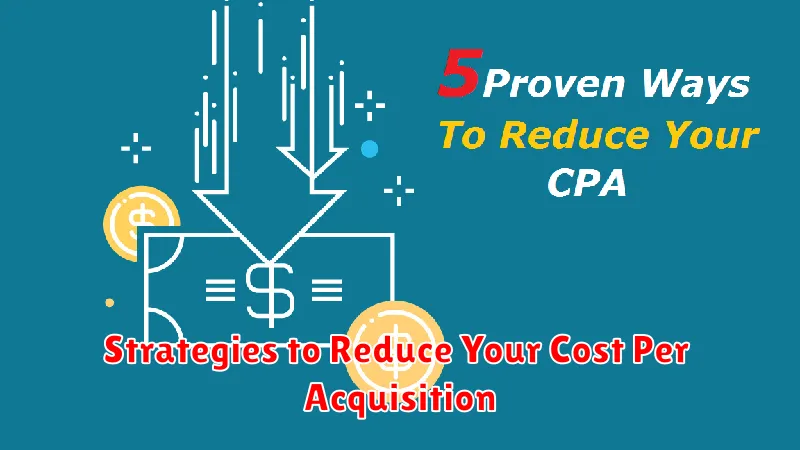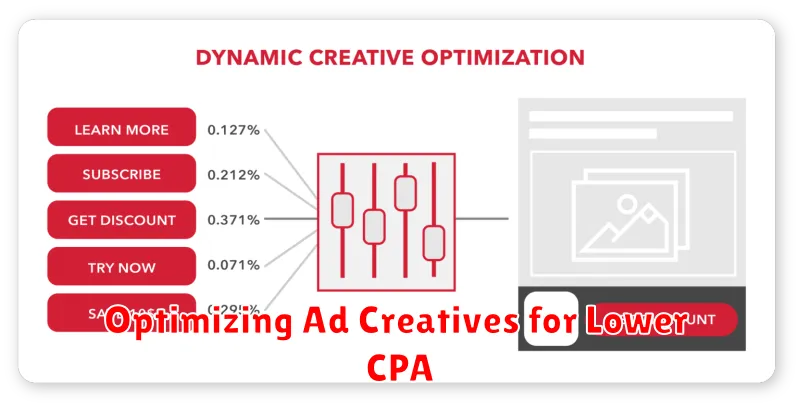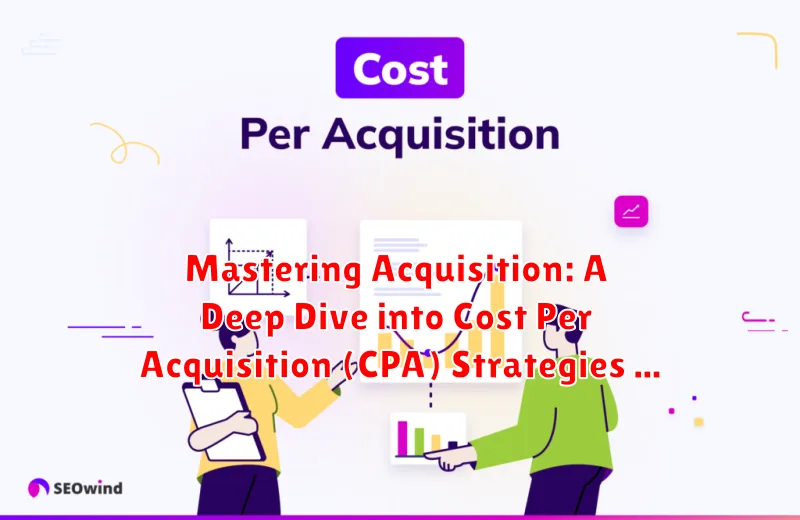In the dynamic landscape of digital marketing, achieving sustainable growth hinges on effectively acquiring new customers. Understanding and optimizing your Cost Per Acquisition (CPA) is paramount to this endeavor. This article, “Mastering Acquisition: A Deep Dive into Cost Per Acquisition (CPA) Strategies,” provides a comprehensive guide to navigating the complexities of CPA, empowering marketers and business owners worldwide to make data-driven decisions and maximize their return on investment (ROI). We will explore various CPA strategies, from refining targeting parameters to optimizing landing pages, ensuring your marketing spend delivers optimal results.
This in-depth analysis will dissect the multifaceted components that influence your CPA, offering actionable insights applicable across diverse industries and marketing channels. We will delve into the nuances of different CPA models, discuss the significance of accurate tracking and attribution, and uncover advanced optimization techniques to lower your acquisition costs while simultaneously enhancing customer lifetime value. Whether you are a seasoned marketing professional or a business leader seeking to enhance your customer acquisition efforts, this article provides a valuable resource for mastering CPA and driving sustainable growth.
Defining Cost Per Acquisition (CPA): What Does It Really Mean?
Cost Per Acquisition (CPA) is a crucial marketing metric that measures the total cost to acquire a single paying customer. It represents the aggregate expense incurred by a business for each conversion directly attributable to a specific marketing campaign or channel.
Essentially, CPA provides a clear understanding of the efficiency of your marketing efforts in converting leads into customers. A lower CPA indicates a more efficient and profitable campaign, while a higher CPA suggests that adjustments are necessary to improve conversion rates and reduce spending.
Understanding your CPA is fundamental to making data-driven decisions regarding marketing budgets and strategy. By accurately tracking and analyzing CPA, businesses can optimize their campaigns, allocate resources effectively, and maximize their return on investment.
CPA vs. Other Marketing Metrics: Understanding the Differences
Cost Per Acquisition (CPA) is often confused with other marketing metrics. Understanding these distinctions is crucial for effective campaign management.
Key Differences
CPA focuses solely on the cost of acquiring a customer who completes a specific action (e.g., purchase, sign-up). Other metrics provide broader insights into campaign performance.
- CPM (Cost Per Mille): Measures the cost per thousand impressions. It reflects ad visibility, not necessarily conversions.
- CPC (Cost Per Click): Measures the cost per click on an ad. It indicates ad engagement but doesn’t guarantee acquisition.
- ROI (Return on Investment): Measures the overall profitability of a campaign, considering all costs and revenue generated.
- CAC (Customer Acquisition Cost): Similar to CPA, but typically includes all marketing expenses, not just advertising costs. It usually refers to the big picture of onboarding a new customer.
While CPM and CPC are useful indicators, they don’t directly reflect the efficiency of acquiring paying customers. CPA provides a more direct measure of marketing effectiveness when the goal is customer acquisition.
Calculating Your Target CPA: A Step-by-Step Guide
Determining your target Cost Per Acquisition (CPA) is crucial for profitable marketing campaigns. This section outlines a straightforward, step-by-step method to calculate a CPA that aligns with your business goals.
Step 1: Determine Your Customer Lifetime Value (CLTV)
First, you must ascertain the Customer Lifetime Value (CLTV). This represents the total revenue a single customer is expected to generate throughout their relationship with your business. Accurate CLTV calculations are essential for setting a realistic CPA target.
Step 2: Define Your Profit Margin
Next, establish your desired profit margin. This is the percentage of revenue you wish to retain after accounting for all associated costs, including marketing expenses.
Step 3: Calculate Allowable Acquisition Cost
With CLTV and profit margin defined, calculate the maximum you can spend to acquire a customer while maintaining your target profitability. A common approach is to take a percentage of your CLTV. For example, if your CLTV is $100 and you want a 20% profit margin, you might allocate 10-15% of the CLTV to acquisition, resulting in a target CPA of $10-$15.
Step 4: Refine Based on Campaign Performance
Finally, remember that your initial target CPA is a starting point. Continuously monitor and adjust your target based on actual campaign performance data. Factors like conversion rates and average order value will influence the optimal CPA.
Strategies to Reduce Your Cost Per Acquisition

Lowering your Cost Per Acquisition (CPA) is crucial for maximizing marketing ROI. Several strategies can be employed to achieve this, focusing on optimizing various aspects of your campaigns.
Enhancing Quality Score
A higher Quality Score on platforms like Google Ads can significantly reduce your CPA. This involves improving ad relevance, landing page experience, and expected click-through rate.
Refining Keyword Targeting
Ensure your keyword targeting is precise. Utilize negative keywords to exclude irrelevant traffic and focus on high-intent keywords that drive conversions.
Improving Ad Relevance
Craft compelling and relevant ad creatives that directly address user search queries. A/B test different ad copy and calls-to-action to identify the most effective combinations.
Optimizing Bidding Strategies
Experiment with different bidding strategies, such as Target CPA or Maximize Conversions, to find the most efficient approach for your specific campaign goals.
Landing Page Optimization
Ensure your landing pages are optimized for conversions. This includes clear messaging, a seamless user experience, and a strong call-to-action.
The Role of Landing Pages in CPA Optimization
Landing pages serve as a critical juncture in the customer acquisition process, directly impacting your Cost Per Acquisition (CPA). They are the specific pages where users “land” after clicking on an advertisement or promotional link. Their effectiveness significantly influences whether a user converts (e.g., makes a purchase, signs up for a newsletter, requests a demo), thus impacting CPA.
A well-optimized landing page can dramatically reduce CPA by:
- Improving Conversion Rates: A clear, concise, and compelling landing page encourages users to take the desired action.
- Enhancing User Experience (UX): A seamless and intuitive experience reduces bounce rates and keeps users engaged.
- Increasing Relevance: Landing pages should be highly relevant to the advertisement or keyword that led the user there, ensuring a consistent message.
Elements such as compelling headlines, clear call-to-actions (CTAs), and persuasive visuals all contribute to landing page optimization for improved CPA performance.
Leveraging A/B Testing to Improve CPA
A/B testing, also known as split testing, is a crucial methodology for optimizing your Cost Per Acquisition (CPA). By systematically comparing two versions of a marketing asset, such as an ad or landing page, you can identify which variation performs better in driving conversions at a lower cost.
The process involves creating two versions (A and B) of an element you want to improve. Each version is shown to a similar audience, and the performance of each is measured, typically focusing on conversion rates and CPA. By analyzing the results, you can determine which version yields a lower CPA and implement the winning version. Continuous A/B testing ensures ongoing improvement and CPA reduction.
Elements that are commonly A/B tested for CPA optimization include:
- Ad Headlines and Copy
- Call-to-Action (CTA) Buttons
- Landing Page Layout and Design
- Images and Videos
- Form Fields
By meticulously A/B testing different elements of your marketing campaigns, you can gain data-driven insights that lead to significant CPA improvements.
Optimizing Ad Creatives for Lower CPA

Ad creatives are a critical lever in controlling your Cost Per Acquisition (CPA). By focusing on compelling visuals, persuasive copy, and clear calls to action, you can significantly improve conversion rates and lower your overall acquisition costs.
Key Elements of High-Performing Ad Creatives
A well-optimized ad creative should incorporate the following:
- Compelling Headline: Grab attention immediately with a benefit-driven headline.
- Engaging Visuals: Use high-quality images or videos that resonate with your target audience.
- Clear Value Proposition: Clearly communicate the benefits of your product or service.
- Strong Call to Action: Tell users exactly what you want them to do (e.g., “Shop Now,” “Learn More”).
Best Practices for Optimization
To effectively optimize your ad creatives, consider these best practices:
- A/B Test: Continuously test different variations of your ad copy, visuals, and calls to action.
- Mobile Optimization: Ensure your creatives are optimized for mobile devices.
- Ad Platform Guidelines: Adhere to the specific guidelines and requirements of each ad platform.
The Impact of Audience Targeting on CPA
Audience targeting plays a crucial role in determining your Cost Per Acquisition (CPA). By precisely identifying and reaching your ideal customer, you can significantly reduce wasted ad spend and improve conversion rates.
Poorly targeted campaigns often result in low engagement and irrelevant clicks, driving up your CPA. Conversely, well-defined audiences lead to higher click-through rates and conversion probabilities, ultimately lowering your acquisition costs.
Benefits of Effective Audience Targeting:
- Reduced ad spend
- Improved conversion rates
- Higher quality leads
- Increased ROI
Consider factors such as demographics, interests, behaviors, and purchase history when defining your target audience. Utilize tools provided by advertising platforms to refine your targeting and ensure your ads are reaching the most receptive users.
Tools and Technologies for CPA Tracking and Analysis
Effective Cost Per Acquisition (CPA) management necessitates the utilization of sophisticated tools and technologies for precise tracking and in-depth analysis. These resources empower marketers to gain granular insights into campaign performance and optimize strategies for enhanced efficiency.
Key Tools for CPA Tracking:
- Google Analytics: A fundamental tool for website traffic analysis, goal tracking, and conversion attribution.
- Google Ads: Provides comprehensive data on ad performance, including impressions, clicks, conversions, and CPA.
- Social Media Advertising Platforms (e.g., Facebook Ads Manager): Offer built-in tracking and analytics for social media campaigns, allowing for CPA measurement on those platforms.
- CRM Systems (e.g., Salesforce, HubSpot): Integrate marketing data with sales data to provide a holistic view of customer acquisition costs.
Technologies for CPA Analysis:
- Attribution Modeling Tools: Help determine the value of each touchpoint in the customer journey, allowing for more accurate CPA calculation.
- A/B Testing Platforms: Facilitate testing of different ad creatives, landing pages, and other marketing elements to identify the most effective approaches for lowering CPA.
- Data Visualization Tools: Help to present CPA data in a clear and understandable format, making it easier to identify trends and patterns.
By leveraging these tools and technologies, marketers can make data-driven decisions to optimize their CPA and maximize return on investment.

